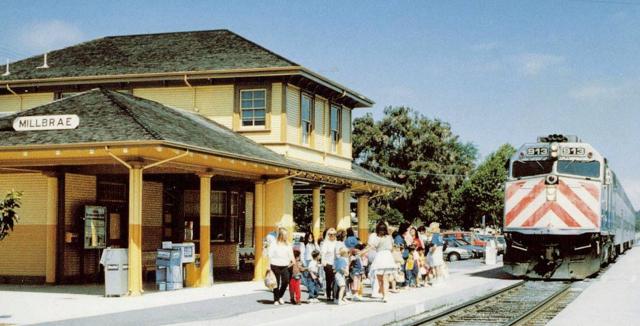Milestones 1990s
November - 1999
Opened the new, relocated Hayward Park station in San Mateo.
May - 1999
Approved the Rapid Rail Plan, an $836 million rehabilitation electrification program.
April - 1999
Opened the San Antonio station in Mountain View. Added weekday trains, bringing the weekday total to 68.
January - 1999
Awarded a $41 million construction contract for 30 projects along the Caltrain right of way. The project is known as the Ponderosa.
December - 1998
Caltrain receives the first of three new locomotives. A celebration was held at Caltrain's Fourth and King streets station in San Francisco to honor the completion of the interior station renovation.
August - 1998
Began selling 10-ride tickets via the internet.
March - 1998
Twenty new passenger cards ordered, six of which are cab cars. Also ordered 101 state-of-the-art ticket vending machines.
July - 1997
Caltrain increases service: six weekday trains and two Saturday trains. Caltrain also introduces a new logo.
June - 1996
Caltrain records the highest annual ridership since 1958 -- 7.4 million.
Nov. 24 - 1995
The number of bicycles allowed per train increases to 24 making Caltrain the least-restrictive and most accessible rail system to bicyclists in the country.
July - 1995
Caltrain becomes accessible to passengers in wheelchairs.
The Redwood City Transit Center, serving Caltrain and SamTrans bus passengers, is dedicated.
Dec. 8 - 1994
Dedication ceremony is held to mark the completion of the reconstruction and restoration of the San Jose terminal, which is renamed "San Jose Diridon Station."
Sept. 17 - 1994
Burlingame station marks 100th anniversary with a community fair.
June-July - 1994
Some 170,000 people take Caltrain to and from World Cup soccer games at Stanford University.
January 15-16 - 1994
Peninsula Corridor Joint Powers Board celebrates 130 years of continuous passenger service between San Francisco and San Jose at an open house marking the 130th anniversary of the Santa Clara depot. It is the oldest continuously operating train station in California.
September - 1992
A limited Bikes-on-Board Program is introduced.
July 1, 1992
The Peninsula Corridor Study Joint Powers Board becomes the Peninsula Corridor Joint Powers Board with Amtrak as contract operator. San Mateo County Transit District provides administration and contract oversite.
Weekday service is increased from 54 to 60 trains.
Tamien station opens in San Jose.
Service is extended to Gilroy.
December - 1991
The Joint Powers Board purchased rail lines in San Mateo and Santa Clara counties. The JPB secured trackage rights to Gilroy for another $4 million, with an option to acquire half the right of way in the future. Union Pacific retains rights to operate freight service in the corridor.
Right of way is purchased from Southern Pacific Transportation Company for $220 million.
